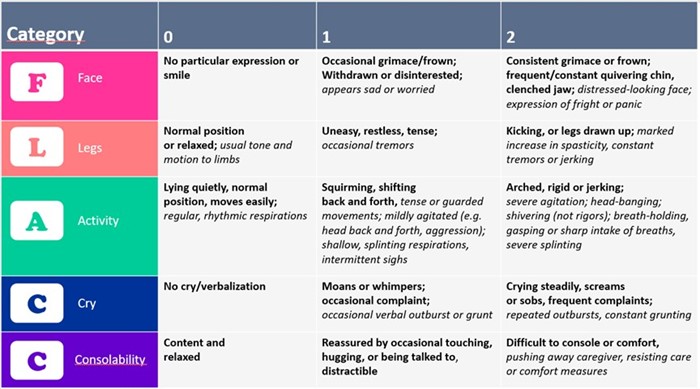A nurse is collecting data from a 3-month-old infant who is 6 hr postoperative following a cleft palate repair.
Which of the following pain rating tools should the nurse use?
FACES Scale
FLACC Scale
Color tool
Numeric scale
The Correct Answer is B
b. FLACC Scale.
Explanation: The FLACC (Face, Legs, Activity, Cry, Consolability) Scale is a pain assessment tool commonly used for infants and young children who are unable to self-report their pain. It assesses five categories of behavior: facial expression, leg movement, activity level, cry, and consolability. Each category is scored from 0 to 2 or 0 to 3, depending on the specific scale used. The scores are then totaled to provide an overall pain assessment.
The FACES Scale, also known as the Wong-Baker FACES Pain Rating Scale, is a tool commonly used for children who can understand and self-report their pain. It consists of a series of faces with different expressions representing varying degrees of pain.
The Color tool is not a recognized pain rating tool. It may refer to an assessment of skin color, which can be used to assess oxygenation or circulation but not specifically for pain.
The Numeric scale is a pain rating tool that involves asking the individual to rate their pain on a scale from 0 to 10, with 0 being no pain and 10 being the worst pain imaginable. However, this scale may not be suitable for a 3-month-old infant who is unable to comprehend numbers or communicate effectively.

Nursing Test Bank
Naxlex Comprehensive Predictor Exams
Related Questions
Correct Answer is ["A","B","E"]
Explanation
Compartment syndrome is a condition characterized by increased pressure within a closed anatomical space, such as a compartment in the leg. This increased pressure can compromise blood flow and nerve function. When assessing a client with a long-leg cast who reports severe pain, the nurse should be vigilant for signs and symptoms of compartment syndrome.
Option a is a correct answer because pallor (paleness) in the exposed portion of the left foot may indicate compromised blood flow due to increased pressure within the compartment.
Option b is a correct answer because the inability to move the left foot suggests impaired nerve function,
which can be a sign of compartment syndrome.
Option c is not a correct answer. Increased warmth is not typically associated with compartment syndrome; instead, it may suggest inflammation or infection.
Option d is not a correct answer. Ecchymosis (bruising) is not typically associated with compartment syndrome, as it is more commonly observed in cases of injury or trauma.
Option e is a correct answer because paresthesia (abnormal sensations like tingling or numbness) in the left foot can indicate nerve compression and is a potential symptom of compartment syndrome.
By identifying the presence of pallor, inability to move the foot, and paresthesia, the nurse can recognize indications of compartment syndrome and take appropriate actions to address the condition promptly.
Correct Answer is B
Explanation
b. A client who has hemiparesis and lives alone.
Explanation:
The correct answer is b. A client who has hemiparesis and lives alone.
An interdisciplinary care conference involves the collaboration of multiple healthcare professionals from different disciplines to develop a comprehensive care plan for a client. In this scenario, the client with hemiparesis who lives alone requires an interdisciplinary care conference because their condition and living situation present complex challenges.
Clients who had surgery for cataract removal and live in a rural location (option a) may require support with transportation and follow-up appointments, but it does not necessarily warrant an interdisciplinary care conference.
A client who requires assistance to pay for dressing supplies (option c) may benefit from financial counseling or resources, but it does not typically require the involvement of multiple healthcare professionals in a care conference.
A client who requires instruction regarding medication administration (option d) can typically receive education from a nurse or pharmacist without the need for an interdisciplinary care conference.
In contrast, the client with hemiparesis who lives alone may require input from various professionals such as physical therapists, occupational therapists, social workers, and home healthcare providers to address their physical limitations, safety concerns, and support needs. Therefore, an interdisciplinary care conference is necessary to develop a comprehensive discharge plan that addresses all aspects of their care and promotes their well-being in the community.
Whether you are a student looking to ace your exams or a practicing nurse seeking to enhance your expertise , our nursing education contents will empower you with the confidence and competence to make a difference in the lives of patients and become a respected leader in the healthcare field.
Visit Naxlex, invest in your future and unlock endless possibilities with our unparalleled nursing education contents today
Report Wrong Answer on the Current Question
Do you disagree with the answer? If yes, what is your expected answer? Explain.
Kindly be descriptive with the issue you are facing.
